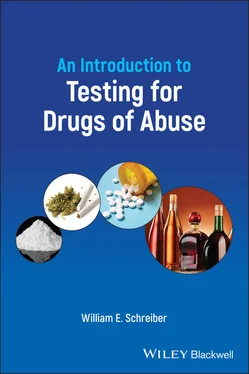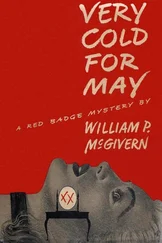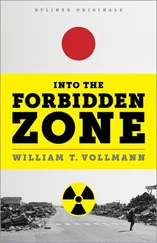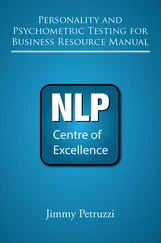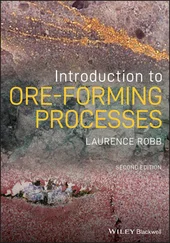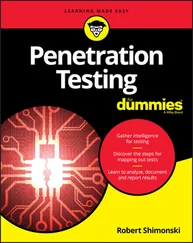William E. Schreiber - An Introduction to Testing for Drugs of Abuse
Здесь есть возможность читать онлайн «William E. Schreiber - An Introduction to Testing for Drugs of Abuse» — ознакомительный отрывок электронной книги совершенно бесплатно, а после прочтения отрывка купить полную версию. В некоторых случаях можно слушать аудио, скачать через торрент в формате fb2 и присутствует краткое содержание. Жанр: unrecognised, на английском языке. Описание произведения, (предисловие) а так же отзывы посетителей доступны на портале библиотеки ЛибКат.
- Название:An Introduction to Testing for Drugs of Abuse
- Автор:
- Жанр:
- Год:неизвестен
- ISBN:нет данных
- Рейтинг книги:3 / 5. Голосов: 1
-
Избранное:Добавить в избранное
- Отзывы:
-
Ваша оценка:
- 60
- 1
- 2
- 3
- 4
- 5
An Introduction to Testing for Drugs of Abuse: краткое содержание, описание и аннотация
Предлагаем к чтению аннотацию, описание, краткое содержание или предисловие (зависит от того, что написал сам автор книги «An Introduction to Testing for Drugs of Abuse»). Если вы не нашли необходимую информацию о книге — напишите в комментариях, мы постараемся отыскать её.
An Introduction to Testing for Drugs of Abuse
An Introduction to Testing for Drugs of Abuse — читать онлайн ознакомительный отрывок
Ниже представлен текст книги, разбитый по страницам. Система сохранения места последней прочитанной страницы, позволяет с удобством читать онлайн бесплатно книгу «An Introduction to Testing for Drugs of Abuse», без необходимости каждый раз заново искать на чём Вы остановились. Поставьте закладку, и сможете в любой момент перейти на страницу, на которой закончили чтение.
Интервал:
Закладка:
Table of Contents
1 Cover
2 Title Page An Introduction to Testing for Drugs of Abuse William E. Schreiber Clinical Director of Chemistry, LifeLabs Professor, Department of Pathology and Laboratory Medicine The University of British Columbia Vancouver, Canada
3 Copyright Page
4 Preface
5 Section I: Substance Use, Drug Metabolism, and the Testing Process 1 Introduction What Is a Drug? How Drugs Work Drug Misuse and Abuse Terminology Economic Impact of Drug Abuse Controlled Substance Schedules Why Test for Drugs of Abuse? What You Will Find in This Book General references Further Reading 2 How the Body Handles Drugs Absorption Distribution Metabolism Excretion Further Reading 3 Specimen Collection Types of Specimens Specimen Validity Testing Further Reading 4 Screening Tests How Immunoassays Work Labels for Competitive Immunoassays Types of Assays Why Immunoassays Sometimes Fail Point‐of‐Care Immunoassays Further Reading 5 Confirmation Tests What is Chromatography? Thin‐Layer Chromatography (TLC) Gas Chromatography (GC) Liquid Chromatography (LC) Mass Spectrometry (MS) Further Reading
6 Section II: Individual Drugs 6 Cocaine How Cocaine Works Physiological Effects Therapeutic Uses Potential for Abuse Metabolism Testing for Cocaine Case Studies Further Reading 7 Amphetamines How Amphetamines Work Physiological Effects Therapeutic Uses Potential for Abuse Individual Drugs Testing for Amphetamines Case Studies Further Reading 8 Benzodiazepines and Z‐drugsBenzodiazepines Z‐Drugs Case Studies Further Reading 9 Other Sedative‐Hypnotic Drugs Barbiturates Gamma‐Hydroxybutyric Acid (GHB) Chloral Hydrate Case Studies Further Reading 10 Opioids How Opioids Work Physiological Effects Therapeutic Uses Potential for Abuse Individual Drugs Testing for Opioids Case Studies Further Reading 11 Cannabinoids How Cannabinoids Work Physiological Effects Therapeutic Uses Potential for Abuse Metabolism Testing for Cannabinoids Case Studies Further Reading 12 Hallucinogens Classic Hallucinogens How Hallucinogens Work Physiological Effects Therapeutic Uses Potential for Abuse Metabolism Testing for Hallucinogens Dissociative Drugs How Dissociative Drugs Work Physiological Effects Therapeutic Uses Potential for Abuse Metabolism Testing for Dissociative Drugs Case Studies Further Reading 13 Alcohols Ethanol Toxic Alcohols Case Studies Further Reading
7 Section III: Appendices Appendix A: How to Read a Toxicology Report Format Screening Tests Confirmation Tests Drugs and Their Metabolites Further Reading Appendix B: Guideline Documents: Pain Management and Addiction Medicine Pain Management Addiction Medicine Further Reading
8 Index
9 End User License Agreement
List of Tables
1 Chapter 1 Table 1.1 Controlled substance schedules in the United States. Table 1.2 Cut‐off concentrations for drugs and metabolites in urine.
2 Chapter 3 Table 3.1 Substance Abuse and Mental Health Services Administration criteri... Table 3.2 Substance Abuse and Mental Health Services Administration criteri... Table 3.3 Substance Abuse and Mental Health Services Administration criteri...
3 Chapter 6Table 6.1 Cross‐reactivity of structurally related compounds in a commercia...
4 Chapter 7Table 7.1 Cross‐reactivity of amphetamine‐type stimulants in a commercial i...Table 7.2 Drugs that can give a positive test result in an immunoassay for ...
5 Chapter 8Table 8.1 Potency, half‐life, and clinical uses of common benzodiazepines....Table 8.2 Cross‐reactivity of selected benzodiazepines in a commercial immu...Table 8.3 Dosage and half‐life of Z‐drugs.
6 Chapter 9Table 9.1 Elimination half‐life data for common barbiturates.Table 9.2 Cross‐reactivity of selected barbiturates in a commercial immunoa...
7 Chapter 10Table 10.1 Relative potency of opioids.Table 10.2 Cross‐reactivity of opioids in a commercial immunoassay.
8 Chapter 11Table 11.1 Cross‐reactivity of cannabinoids in a commercial immunoassay....
9 Chapter 12Table 12.1 Elimination half‐life data for hallucinogens.Table 12.2 Drugs that can give a false‐positive immunoassay result for phen...
10 Chapter 13Table 13.1 Signs and symptoms of alcohol intoxication.Table 13.2 Criteria for alcohol use disorder according to the Diagnostic an...Table 13.3 Specimen type and window of detection for markers of alcohol con...
11 Appendix ATable A.1 Amphetamine‐type stimulants, cocaine, and their metabolites.Table A.2 Benzodiazepines and their metabolites.Table A.3 Opioids and their metabolites.Table A.4 Alcohols, cannabis, and their metabolites.
List of Illustrations
1 Chapter 1 Figure 1.1 Graph comparing harm to users (x‐axis) vs harm to others (y‐axis)... Figure 1.2 Costs of substance use in Canada in 2017. For each substance, the...
2 Chapter 2 Figure 2.1 Structures of uridine diphosphate (UDP) glucuronic acid and phosp...
3 Chapter 4 Figure 4.1 Radioimmunoassay (RIA). A drug labeled with a radioisotope compet... Figure 4.2 Enzyme multiplied immunoassay technique (EMIT). An enzyme attache... Figure 4.3 Cloned enzyme donor immunoassay (CEDIA). The free donor–drug comp... Figure 4.4 Kinetic interaction of microparticles in solution (KIMS). The dru...Figure 4.5 Lateral flow immunoassay. (a) A patient sample is applied to the ...
4 Chapter 5Figure 5.1 Diagram of a gas chromatograph. The carrier gas flows from the ga...Figure 5.2 Blood alcohols separated by gas chromatography. The x‐axis gives ...Figure 5.3 Prescription opioids and their metabolites separated by liquid ch...Figure 5.4 Components of a mass spectrometer. The ion source generates charg...Figure 5.5 Mass spectrum of benzoylecgonine, the major metabolite of cocaine...
5 Chapter 6Figure 6.1 Dried leaves from the coca plant, Erythroxylon coca .Figure 6.2 Structures of cocaine and its major metabolites. Circles and elli...
6 Chapter 7Figure 7.1 Structures of amphetamine, methamphetamine, and the neurotransmit...Figure 7.2 Structures of methylenedioxyamphetamine (MDA), methylenedioxymeth...Figure 7.3 Structures of p‐methoxyamphetamine (PMA) and p‐methoxymethampheta...Figure 7.4 Structures of cathinone and the synthetic derivatives methcathino...Figure 7.5 Structures of ephedrine/pseudoephedrine, phentermine, and methylp...
7 Chapter 8Figure 8.1 Structures of diazepam and chlordiazepoxide. The differences betw...Figure 8.2 Structures of temazepam, oxazepam, and lorazepam. These drugs are...Figure 8.3 Structures of alprazolam and triazolam.Figure 8.4 Structures of clonazepam and flunitrazepam. Flunitrazepam has bee...Figure 8.5 Metabolism of benzodiazepines. Clorazepate is an inactive prodrug...Figure 8.6 Structures of the Z‐drugs.Figure 8.7 Structure of etizolam. A circle surrounds the thiophene ring that...
8 Chapter 9Figure 9.1 Structures of some common barbiturates. Each compound has two sid...Figure 9.2 Structures of gamma‐hydroxybutyric acid (GHB) and the inhibitory ...Figure 9.3 Structures of chloral hydrate and its active metabolite trichloro...
9 Chapter 10Figure 10.1 Picture of the opium poppy, Papaver somniferum .Figure 10.2 Structures of morphine, codeine, and commonly used semisynthetic...Figure 10.3 Structures of commonly prescribed synthetic opioids. None of the...Figure 10.4 Structures of naloxone, an opioid antagonist, and buprenorphine,...
10 Chapter 11Figure 11.1 Picture of Cannabis sativa plants.Figure 11.2 Structures of Δ 9‐tetrahydrocannabinol (THC), its metabolites 11‐...Figure 11.3 Mean plasma levels of THC, 11‐OH‐THC and THC‐COOH during and aft...
11 Chapter 12Figure 12.1 Structures of the neurotransmitter serotonin and the hallucinoge...Figure 12.2 Psilocybe cubensis , a species of psilocybin‐containing mushrooms...Figure 12.3 (a) Structure of mescaline (3,4,5‐trimethoxyphenylethylamine). (...Figure 12.4 Structures of the dissociative drugs phencyclidine and ketamine....
Читать дальшеИнтервал:
Закладка:
Похожие книги на «An Introduction to Testing for Drugs of Abuse»
Представляем Вашему вниманию похожие книги на «An Introduction to Testing for Drugs of Abuse» списком для выбора. Мы отобрали схожую по названию и смыслу литературу в надежде предоставить читателям больше вариантов отыскать новые, интересные, ещё непрочитанные произведения.
Обсуждение, отзывы о книге «An Introduction to Testing for Drugs of Abuse» и просто собственные мнения читателей. Оставьте ваши комментарии, напишите, что Вы думаете о произведении, его смысле или главных героях. Укажите что конкретно понравилось, а что нет, и почему Вы так считаете.
